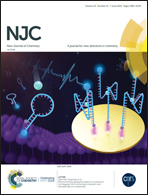Anisotropic magnetite nanoclusters with enhanced magnetization as an efficient ferrofluid in mass transfer and liquid hyperthermia†
Abstract
Magnetic nanoparticles have a wide range of applications in magneto-optics, sensors, magnetic resonance imaging, ferrofluids, magnetic hyperthermia and drug delivery systems. Herein, Fe3O4 nanoclusters were prepared through the solvothermal method and modified by chemisorption of polyacrylic acid (PAA). The obtained magnetite nanoparticles were characterized by FTIR, XRD, TGA, TEM and VSM analyses. It was found that they were monodisperse with the size of about 8–10 nm and formed grape-like nanoclusters with the uniform size of 70–100 nm. The magnetic properties of the Fe3O4@PAA nanoclusters showed that they were superparamagnetic with almost no hysteresis loop. A colloidal dispersion of the modified Fe3O4 nanoclusters in water was highly stable for up to at least 180 days and exhibited no change in its dispersibility. This was confirmed by zeta potential assessment at different pH and time intervals. Then, they were used as a ferrofluid for mass transfer and also liquid magnetic hyperthermia by an alternating magnetic field for heat build-up in a system, and the results showed their reasonable performance. The magnetorheological properties of a 15 wt% dispersion in water were investigated by rotational rheometry under various magnetic fields, and it demonstrated a reasonable ferrofluid behavior.



 Please wait while we load your content...
Please wait while we load your content...